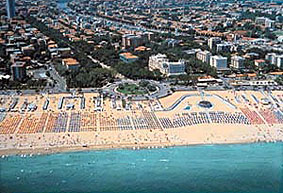


All the structures

Rimini, a province in Emilia Romagna, is known for its coast and as an famous holiday resort that has given rise to what we call today ‘mass tourism’.
Its position on the Adriatic Sea and the road and rail network that serves it, have helped tourism to develop extensively along its riviera.
Rimini’s historic centre contains Roman and Renaissance monuments of great interest.
Visit Piazza Tre Martiri and the Cathedral or ‘Malatesta Temple’ of Gothic origin. The famous architect Leon Battista Alberti later built a Renaissance-style shell around the church. Inside you can admire a fresco by Piero della Francesca (1451) and a cross by Giotto (1400). Rimini has the oldest of the surviving Roman arches, built in 27BC to honour Augustus. Also beautiful to see is The Bridge of Tiberius, built between 14 and 21 AD.
Besides its riviera, Rimini offers travellers interesting inland locations. San Marino is situated twenty kilometres from Rimini. San Marino is a small, independent state located on Mount Titano. Tradition has it that the Republic of San Marino was founded at the beginning of the fourth century by a stonemason named Marino who fled Diocletian’s persecutions.
Mount Titano’s three peaks are called ‘The Feathers’.
On Mount Giove lies Santarcangelo di Romagna, known for its medieval town centre. Among the most interesting monuments is the Malatesta Fortress with three polygonal towers, built in 1447. Artworks of the Emilian and Romagna schools are kept in the Historical and Archaeological Museum.
Overlooking the sea in the province of Rimini is Montefiore Conca with its parallelepiped-shaped fort. Nearby, visit the Onferno Reserve and Caves. The reserve is home to hundreds of specimens of bats. Onferno is a complex karst formation in which narrow tunnels alternate with larger spaces. According to local history, until the 1800s Onferno was called Inferno, and its forms inspired Dante’s descriptions.